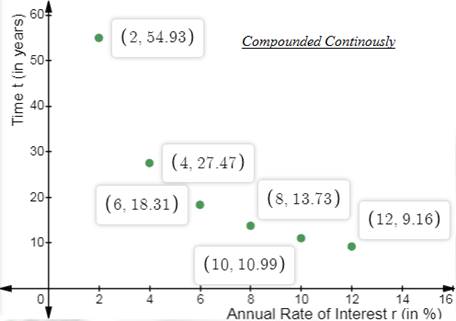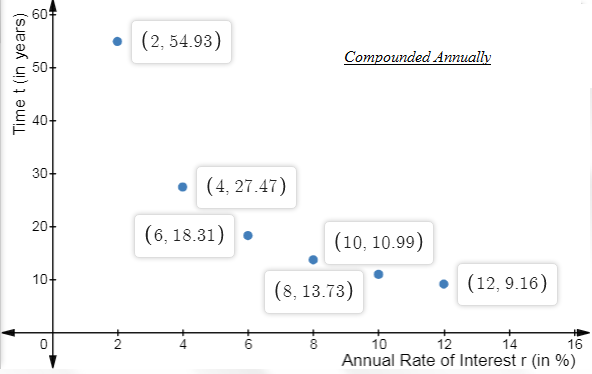
Concept explainers
To find : the graph of data found relating the rate of interest and time required for investment to Triple for both compound continuously and annually.
Answer to Problem 18E
The equation relating the rate of interest (r) and time (t) in years:
For investment compounded continuously is given by:
For investment compounded annually is given by:
Explanation of Solution
Given information : Annual rate of interest is given by r & time (number of years) is given by t.
The completed table for time t (in years) necessary for P dollars to triple when it is invested at an interest rate r compounded continuously is given below:
| r | ||||||
| t (in years) | 54.93 | 27.47 | 18.31 | 13.73 | 10.99 | 9.16 |
The completed table for time t (in years) necessary for P dollars to triple when it is invested at an interest rate r compounded annually is given below:
| r | ||||||
| t (in years) | 55.48 | 28.01 | 18.85 | 14.27 | 11.53 | 9.69 |
Concept Involved:
We need to make us of the below steps to graph the set of data given in the calculator
| Steps | Description |
| Enter the data into the lists. For basic entry of data, see Basic Commands. |
| Steps | Description |
| Go to STATPLOT (2nd Y=) and choose the first plot. Turn the plot ON, set the icon to Scatter Plot (the first one), set Xlist to L1 and Ylist to L2 (assuming that is where you stored the data), and select a Mark of your choice. | |
| Press STAT, arrow right to CALC, and arrow down to A: PwrReg. Hit ENTER. When PwrReg appears on the home screen, type the parameters L1, L2, Y1. The Y1 will put the equation into Y= for you. (Y1 comes from VARS ? YVARS, #Function, Y1) | |
| Graph the Power Regression Equation from Y1. ZOOM #9 ZoomStat to see the graph. |
Graph:


Interpretation:
The equation relating the rate of interest (r) and time (t) in years for investment compounded continuously is given by:
The equation relating the rate of interest (r) and time (t) in years for investment compounded annually is given by:
Chapter 3 Solutions
EBK PRECALCULUS W/LIMITS
- Consider the following system of equations, Ax=b : x+2y+3z - w = 2 2x4z2w = 3 -x+6y+17z7w = 0 -9x-2y+13z7w = -14 a. Find the solution to the system. Write it as a parametric equation. You can use a computer to do the row reduction. b. What is a geometric description of the solution? Explain how you know. c. Write the solution in vector form? d. What is the solution to the homogeneous system, Ax=0?arrow_forward2. Find a matrix A with the following qualities a. A is 3 x 3. b. The matrix A is not lower triangular and is not upper triangular. c. At least one value in each row is not a 1, 2,-1, -2, or 0 d. A is invertible.arrow_forwardFind the exact area inside r=2sin(2\theta ) and outside r=\sqrt(3)arrow_forward
- A 20 foot ladder rests on level ground; its head (top) is against a vertical wall. The bottom of the ladder begins by being 12 feet from the wall but begins moving away at the rate of 0.1 feet per second. At what rate is the top of the ladder slipping down the wall? You may use a calculator.arrow_forwardExplain the focus and reasons for establishment of 12.4.1(root test) and 12.4.2(ratio test)arrow_forwarduse Integration by Parts to derive 12.6.1arrow_forward
- Explain the relationship between 12.3.6, (case A of 12.3.6) and 12.3.7arrow_forwardExplain the key points and reasons for the establishment of 12.3.2(integral Test)arrow_forwardUse 12.4.2 to determine whether the infinite series on the right side of equation 12.6.5, 12.6.6 and 12.6.7 converges for every real number x.arrow_forward
 Calculus: Early TranscendentalsCalculusISBN:9781285741550Author:James StewartPublisher:Cengage Learning
Calculus: Early TranscendentalsCalculusISBN:9781285741550Author:James StewartPublisher:Cengage Learning Thomas' Calculus (14th Edition)CalculusISBN:9780134438986Author:Joel R. Hass, Christopher E. Heil, Maurice D. WeirPublisher:PEARSON
Thomas' Calculus (14th Edition)CalculusISBN:9780134438986Author:Joel R. Hass, Christopher E. Heil, Maurice D. WeirPublisher:PEARSON Calculus: Early Transcendentals (3rd Edition)CalculusISBN:9780134763644Author:William L. Briggs, Lyle Cochran, Bernard Gillett, Eric SchulzPublisher:PEARSON
Calculus: Early Transcendentals (3rd Edition)CalculusISBN:9780134763644Author:William L. Briggs, Lyle Cochran, Bernard Gillett, Eric SchulzPublisher:PEARSON Calculus: Early TranscendentalsCalculusISBN:9781319050740Author:Jon Rogawski, Colin Adams, Robert FranzosaPublisher:W. H. Freeman
Calculus: Early TranscendentalsCalculusISBN:9781319050740Author:Jon Rogawski, Colin Adams, Robert FranzosaPublisher:W. H. Freeman
 Calculus: Early Transcendental FunctionsCalculusISBN:9781337552516Author:Ron Larson, Bruce H. EdwardsPublisher:Cengage Learning
Calculus: Early Transcendental FunctionsCalculusISBN:9781337552516Author:Ron Larson, Bruce H. EdwardsPublisher:Cengage Learning





